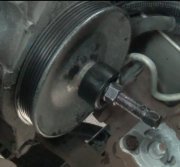There's lots of possible causes. You didn't list an engine size or truck size, so that adds even more variables. If your truck has a common steering gear box, that could be out of adjustment. Once a little play develops, the normal hammering action from bumps in the road increase that play at a faster and faster rate until it gets to the point where you observe excessive steering wander. That is where you have to constantly keep on correcting the steering wheel to keep the truck going straight. That can make for a very tiring vehicle to drive.
If your truck has rack and pinion steering, typically found on lighter vehicles with smaller engines, it is less likely it is out of adjustment, but it is not uncommon for the mounting bolts to work loose. You'll usually hear a soft clunking noise when turning the steering wheel, and typically the truck will suddenly dart in an unexpected direction while driving.
This article describes the two steering systems:
https://www.2carpros.com/articles/how-car-steering-works
Another source of steering wander is a worn universal joint in the steering shaft. Those are usually found under the dash. Clunking or binding while turning will usually also occur.
This would be the time to have the truck inspected at a tire and alignment specialty shop. Those inspections are often at no charge, especially if you have the repairs done there. The people there are experts at finding the causes of noises, vibrations, bad tire wear patterns, and other steering and handling problems. Additional items they'll look at include ball joints, tie rod ends, idler arms, pitman arms, anti-sway bar links, and control arm bushings. On larger vehicles such as trucks, worn tie rod ends can cause steering wander, but they usually don't cause you to notice a delay in wheel movement relative to steering wheel movement when you're standing next to the vehicle. Same with ball joints. A badly-worn tie rod end will separate leading to loss of control and a crash before it causes noises. Most lower ball joints can't separate, but they will causes clunking noises when they get really worn. Most commonly, upper ball joints will cause one clunk when turning to one side, then another clunk when you straighten out. They can separate if ignored for a long time, but they don't really cause excessive steering wander, and you won't notice delayed wheel response when turning the steering wheel.
Inspections can take as much as a half hour. Most of the parts I listed, if replaced, require an alignment, as no two parts are ever exactly the same. Conscientious alignment specialists will not take your money or agree to align your truck if they know there's worn parts on it. The know they can't deliver satisfactory results or solve problems if worn parts are ignored.
They will also measure suspension ride height at the front and rear. There's published legal specifications the truck must sit at to maintain the proper geometric relationship between the steering and suspension systems. This is especially important here based on the age of your truck. Weak / sagged springs let the truck sit too low. Because of the sagged ride height and incorrect arcs the control arms travel through, there will be accelerated tire wear even when the numbers on the alignment computer's screen look perfect. They'll want to correct ride height with new springs before they agree to align the truck. Replacing rear coil springs only takes a few minutes. If you have rear leaf springs, that is a much bigger job. Front coil springs can be replaced usually in less than two hours.
Wednesday, December 23rd, 2020 AT 11:51 AM


